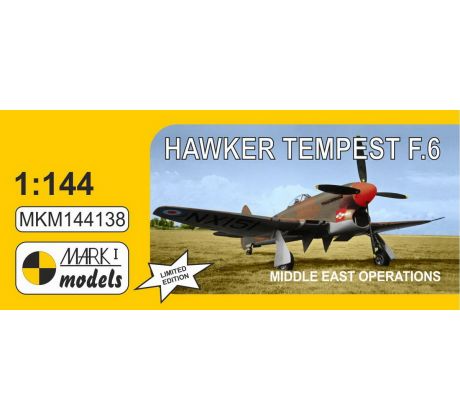- Armory
- Brengun
- JBR Models
- LF Models
- Mark I Models
- Miniwing
-
Peewit Canopy Masks
- A-model 1:72
- Ace 1:72
- Airfix 1:144
- Airfix 1:72
- Airfix 1:48
- AML
- AZ model 1:72
- Clear Prop! 1:144
- Clear Prop! 1:72
- Heller 1:144
- ICM 1:72
- Italeri 1:72
- Kovozavody P. 1:72
- LF Models 1:144
- LF Models 1:72
- LF Models 1:48
- Miniwing 1:144
- Mark I Models 1:144
- Sabre Kits 1:72
- Special Hobby 1:72
- Special Hobby 1:48
- Valom 1:144
- Rise144models
- Shelf Oddity
- Valom
- Second Hand 1:144
Tempest F.6 'Middle East Operations'

Tempest F.6 'Middle East Operations'
Description: This injection-moulded kit (one model is included) contains 37 parts, 3 resin parts (the wing, the radiator and a Pitot tube) and one clear part (the cockpit canopy). A comprehensive decal sheet is included.
Colour schemes included in the kit:
1) Hawker Tempest F Mk.6, NX129, Sky JV-D, No.6 Sq., Royal Air Force, RAF Station Khartoum, Sudan, spring 1948
2) Hawker Tempest F Mk.6, NX143, Red GN-H, No.249 'Gold Coast' Sq., Royal Air Force, Habbaniya Air Base, Iraq, 1947
3) Hawker Tempest F Mk.6, NX151, White E, No.213 'Ceylon' Sq., Royal Air Force, RAF Station Deversoir (Abu Sultan), Egypt, 1949
4) Hawker Tempest F Mk.6, NX135, Black V, No.6 Sq., Royal Air Force, detachment at RAF Station Nicosia, Cyprus, early 1949
| Ref. No.: | MKM144138 |
| Availability: | IN STOCK |
Tempest F.6 'Middle East Operations'
Hawker Tempest F.6 'Middle East Operations'
The Hawker Tempest Mk.VI was the RAF's piston-engined fighter, which evolved as a Mk.V development with a more powerful Sabre V engine. Its prototype first flew in May 1944, while the first aircraft were available in July - August 1945.
As with other Tempests, Mk.VI orders were reduced when the war ended. Of 300 plus aircraft only 142 were actually built. They were delivered to five RAF squadrons in the Middle East in 1946/47 Nos.247 and 6 Squadrons being the first, followed by Nos. 213, 8 and 39.
The Tempest Mk.VI was a single-seat monoplane aircraft, of all metal construction, powered by a Napier Sabre V or VA engine. DH or Rotol four-bladed propellers were used. It featured a bubble canopy and a retractable undercarriage. Compared to the Mk.V it had carburettor air intakes repositioned to the wing roots, oil cooler placed behind the the coolant radiator and additional oil coolant radiator installed in the starboard wing. It was fitted with four 20mm Hispano cannons in the wings and it could carry 45-gal or 90-gal drop tanks. The Tempest could also perform as a fighter-bomber, carrying a wide variety of bombs up to 1000 lbs.
The Tempest Mk.VIs (re-designated F Mk.6 in mid-1947) were involved in such delicate actions in the ME region, such as Canal Zone defence, the British Palestine handover, Israeli-Egyptian hostilities and unrests in Iraq and Eritrea. By March 1950 all the units gave up their Tempests.
Products purchased together with this product
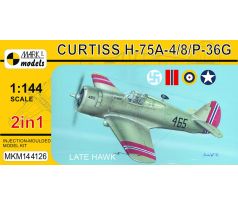
Curtiss H-75A-4/8/P-36G 'Late Hawks'
Two injection-moulded kits are supplied in this box and each kit contains 23 parts and four clear parts (the cockpit canopy, rear windows and a landing light). A comprehensive decal sheet is included.
Colour schemes included in the kit:
1) Curtiss H-75A-4, CUc-504, (ex-French H-751 No.24/ex-Luftwaffe DS+NQ), 1/LeLv 12 (Fighter Sq.), Finnish Air Force (Ilmavoimat), Joroinen airfield, Finland, summer 1941
2) Curtiss H-75A-8, No. 465, ‘Little Norway’ Air Force Training Camp, Norwegian Army Air Service (Hærens flyvåpen), Toronto Island Airport, Ontario, Canada, 1942-43
3) Curtiss Mohawk Mk.IV, BS734, White 14, Air Transport Auxiliary Flight, Royal Air Force, Wroughton airfield, Wiltshire, U.K., 1941
4) Curtiss P-36G (ex-Norwegian H-75A-8), s/n 42-108995, Yellow 2108995, USAAF, Patterson Field, Ohio, U.S.A., early 1943
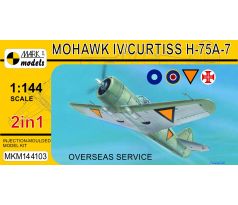
Mohawk IV/Curtiss H-75A-7 'Overseas Service'
Two injection-moulded kits are supplied in this box and each kit contains 21 parts and four clear parts (the cockpit canopy, rear windows and a landing light). A comprehensive decal sheet is included.
1) Curtiss Mohawk Mk.IV, BS734, Grey A, ‘Joe Soap II’, No.155 Sq., Royal Air Force, Imphal airfield, Northeast India, late 1943
2) Curtiss Mohawk Mk.IV, BB977, Black D, No.5 Sq., Royal Air Force, Agartala airfield, Northeast India, January 1943
3) Curtiss H-75A-7, s/n C-332, Black C332, 1-VLG-IV (1st Sq., 4th Aircraft Group), Royal Netherlands East Indies Army Air Force (Militaire Luchtvaart – Koninklijk Nederlandsch-Indisch Leger, ML-KNIL), Madiun airfield, Java, Netherlands East Indies, early 1941
4) Curtiss Mohawk Mk.IV, 485 (ex-RAF Mohawk Mk.IV, s/n unknown), White XY-F/485, ‘XY’ Flt., E.E.C. 3 (Esquadrilha Expedicionária n° 3), Portuguese Air Force (Aeronáutica Militar), Ota airfield (BA 2), Portugal, summer 1943
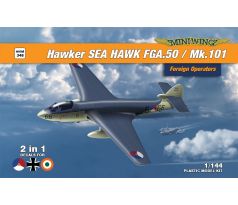
Hawker SEA HAWK FGA.50 / Mk.101 Foreign Operators
British Carrier Based Fighter / Attacker
Description:
30 plastic parts
2 kits in the box
decals for 3 versions of Netherland, West Germany and India
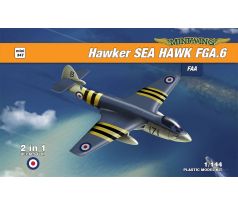
Hawker SEA HAWK FGA.6 FAA
British Carrier Based Fighter / Attacker
Description:
30 plastic parts
2 kits in the box
decals for 3 versions of FAA
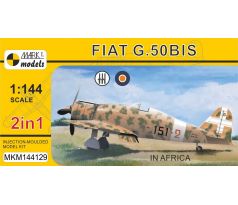
Fiat G.50bis 'In Africa' (2in1)
Two injection-moulded kits are supplied in this box and each kit contains 36 parts and one clear part (the cockpit windshield). A comprehensive decal sheet is included.
Fiat G.50 'In Africa' (2in1 = 2 kits in 1 box) (Italian AF, South African AF)
The Fiat G.50 was an Italian fighter aircraft designed in the mid-1930s, which became the most advanced fighter to be produced in Italy at that time. The prototype flew in February 1937, while the first production aircraft were delivered to the air force two years later.
In the autumn of 1940, an improved version with an extended combat range was introduced and designated the G.50bis. In total, production of the G.50 reached 784 aircraft in seven production series; 426 of which were manufactured by Fiat (Aeritalia) and another 358 were built by CMASA. 58 aircraft were exported: 13 G.50s to Spain, 35 aircraft to Finland and 10 went to Croatia.
It was a single-seat, all-metal low-wing monoplane featuring an open cockpit and a retractable undercarriage. It was powered by a Fiat A.74 two-row radial engine and was fitted with a Hamilton-Fiat propeller. The first versions of the G.50 were fitted with different configurations of armament: either a single or a pair of 12.7mm machine guns in the nose and an additional pair of 7.7mm guns in the wings. The Fiat G.50bis can be distinguished by the redesigned tail, addition of a larger rudder and relocated tail wheel.
The Fiat G.50s were extensively used on various fronts by Italy, including deployment in Belgium, North Africa, in the Balkans, in the Aegean and the Italian mainland. In Finland they served with distinction during the Winter War of 1940 and the Continuation War of 1941a"44 against the Soviet Union.



